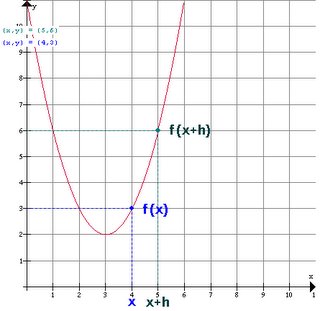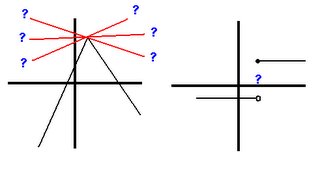Section 2.6
Derivative:
Slope of the tangent line
Instantaneous rate of change
Step 1: f(x) = x2 + 5x
f(x + h) = (x + h)2 + 5(x + h)
= x2 + 2xh + h2 + 5x + 5h
The Slope Formula:
f(x + h) – f(x)
x + h – x
Step 2: [(x2 + 2xh + h2 + 5x) – (x2 + 5x)] / h
Step 3:
(2xh + h2 +5h) / h
lim h à 0
Step 4:
2x +h + 5 = 2x + 5 make the h = 0 because the limit of h is 0
lim h --> 0
Tip: You must put the equation of the line tangent to the chosen point in point-slope formula or the slope intercept form.
i.e. if according to our step 4, f(3) = 11 you will put it in:
Point Slope: y – 24 = 11(x – 3)
Slope Intercept: y = 11x – 33 + 24 = 11x – 9
Since at the time of the development of Calculus many different mathematicians from different countries found it at the same time, there are many different notations that mean essentially the same thing.
i.e. f1(x), y1, dy/dx, Dx(y), Dxf(x)
Differentiability
Many functions have derivatives, but some functions have areas where you
cannot draw a tangent line.
i.e.
When the graph of a function has a derivative at a point or interval, it is said to be differentiable
Hint: Differentiability implies continuity
Examples
To find the average rate of change:
Essentially step two above with numbers in place of the variables
For f(t) = 2t2 what is the average velocity of [22,23] seconds?
f(23sec) = 1058ft f(22sec) = 968ft
(1058 – 968) / (23 – 22) = 90 / 1 = 90 ft/sec
To find the instantaneous rate of change:
Essentially the entire 4 step process with numbers in place of the variables
For the same f(t) what is the instantaneous velocity at [22] seconds?
f(t + h) = 2(t + h)2
= 2(t2 + 2th + h2)
= 2t2 + 2th + 2h2
(2t2 + 4th + 2h2 – 2t2) / h = 4t +2h = 4t
lim h --> 0
[22sec] --> 4t = 88 ft/sec
for Extra assistance visit http://tutorial.math.lamar.edu/AllBrowsers/2413/Differentials.asp




1 Comments:
Kyong, the tips for finding the tangent line really helped because I didn't realize that we had to solve for the slope by plugging in x before putting it into slope-intercept form. Thanks.
Post a Comment
<< Home